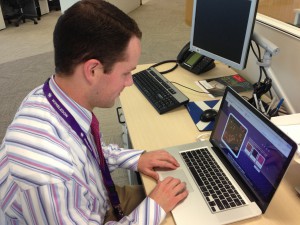29th July 2013 Los Angeles, USA
Crowdsourcing Science: Becoming Citizen Scientists
While studying international affairs in graduate school at Penn State, I found others like me who wanted to “save the world.” I’m not talking about becoming a super hero in the hottest comic book flying off the shelves, but we were in school to develop skills that would help put us in a position to be able to make a true positive impact locally and globally. Future researchers, educators, policy makers, Foreign Service officers, etc – we wanted to do it all! Eventually one realises that there are many other ways to make a difference too regardless of age, educational background, or profession – even when it comes to fields like science and finding treatments for diseases.
To complement traditional public service such as volunteerism, today there are more opportunities than ever for the public to support the efforts of researchers who are tackling challenges like cancer, climate change, and renewable energy. This is really exciting for someone like me who is enthusiastic about science, but doesn’t have a science degree. We all can be citizen scientists.
Take for example Cell Slider, which is a collaborative initiative of Cancer Research UK (CRUK) and Zooniverse. CRUK conducts cancer research to prevent, control, and cure cancer in addition to educating patients about cancer and influencing legislation to keep cancer a priority on the UK’s health agenda. Zooniverse is an online platform that allows citizen scientists a chance to get involved in various research projects online in topics ranging from space research to climate and biology. With one click at a time, Cell Slider allows the public a chance to help researchers analyse real breast cancer data.

Photo Credit: Sally Mouakkad
How does this work? The user is presented with an image, which could be of irregular cells, tissue, or blood cells, which are contributed samples from voluntary participants of clinical trials in the UK. It’s the user’s job to figure out what it is. If irregular cells are spotted, he or she is asked to, estimate how many irregular cells, the proportion of irregular cells that are stained yellow, and to indicate how bright yellow the irregular cells appear. That’s it! And, don’t worry too much about responses being 100% accurate as each slide is analysed by many others, and ultimately by the researchers themselves.
The work and time that citizen scientists put into analysing cancer cells on Cell Slider allows cancer researchers to focus on other important research. It also speeds up the processes of analysing cancer cell data overall. Cell Slider depends on high volume contributions from the public: the higher the number of citizen scientists analysing each slide, the more accurate the data becomes. The online system ensures that enough people analyse each slide so that with each click, you really are making a powerful difference by helping researchers develop better cancer treatments.
So, if you’re intrigued and feeling inspired, why not give being a citizen scientist a try? Find something out there that interests you and contribute to science – the results found will benefit us all.